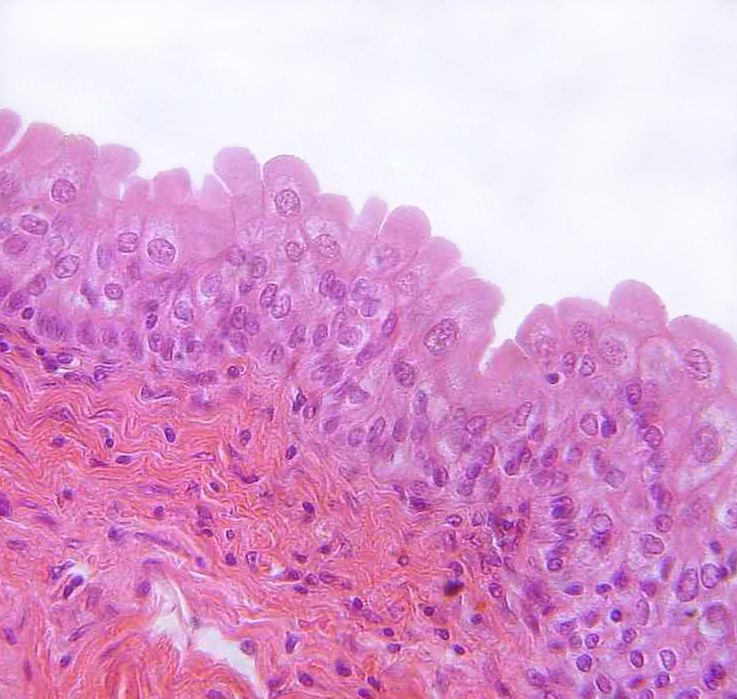Urothelium (or uroepithelium) is an example of "transitional epithelium". It is the type of epithelium that lines much of the urinary tract including the renal pelvis, the ureters, the bladder, and parts of the urethra.
Structure and function
Urothelial tissue is highly specific to the urinary tract, and has high elasticity and trans-epithelial electrical resistance.
Urothelium consists of approximately 3-5 cell layers, accompanied by a thick layer of protective glycoprotein plaques at its luminal (apical) surface, and is classified as transitional epithelium.
Epithelia are sites of specific diseases.
Cancers that originate in epithelial cells are termed carcinomas, and they are characterized as having lost the mature, differentiated morphology and molecular patterns of the normal tissue. Infectious diseases also afflict epithelia where diverse microbes (viruses, bacteria, fungi) have surface structures that bind specific features of particular epithelial cells (e.g., influenza virus binds respiratory epithelium). Genetic defects can also inhibit normal epithelial integrity, such as defects in intercellular adhesion molecules that result in blistering diseases.
The second most common infectious disease is urinary tract infection (UTI). UTIs afflict approximately half of all women during their lifetime, and about 25% of these women will suffer recurrent UTIs. The majority of these infections are due to uropathogenic Escherichia coli bacteria (commonly known as E. coli). However, UTIs can also develop in healthcare settings and such infections are caused by a greater frequency of non-E. coli bacteria.
One unusual condition which affects the urothelium is interstitial cystitis (IC), a condition with symptoms similar to UTI (urinary frequency, urinary urgency, pressure and/or pain). Urine culture, however, is negative. During hydrodistention of the bladder, small petechial hemorrhages (aka glomerulations) are frequently found throughout the bladder. Larger "Hunner's Ulcers", known for their characteristic waterfall bleeding effect, represent larger areas of bladder wall thinning and/or trauma. The cause of IC is currently unknown though some suggest that it could be genetic, the result of traumatic injury (aka chemical exposure), infection, autoimmune disease, etc. Researcher Susan Keay (University of Maryland) has found an unusual protein in the urine of IC patients which appears to interfere with healing, known as an Antiproliferative Factor. Research efforts into IC are focused on the urothelium, including newly discovered signaling molecules which suggest that the urothelium is far more than a barrier, as well as how the urothelium interacts with proximal nerves and smooth muscle.
Urothelium is susceptible to carcinoma. Because the bladder is in contact with urine for extended periods, chemicals that become concentrated in the urine can cause Bladder cancer. For example, cigarette smoking leads to the concentration of carcinogens in the urine and is a leading cause of bladder cancer. Aristolochic acid, a compound found in plants of the Aristolochiaceae family, also causes DNA mutations and is a cause of liver, urothelial and bladder cancers. Occupational exposure to certain chemicals is also a risk factor for bladder cancer. This can include aromatic amines (aniline dye), polycytic aromatic hydrocarbons, and diesel engine exhaust.
Papillary urothelial lesions
Papillary urothelial hyperplasia
Urothelial papilloma
Papillary urothelial neoplasm of low malignant potential (PUNLMP)
Low-grade papillary urothelial carcinoma
High-grade papillary urothelial carcinoma
Invasive urothelial carcinoma
Flat urothelial lesions
Reactive urothelial atypia
Urothelial inverted papilloma
Urothelial atypia of unknown significance
Urothelial dysplasia
Urothelial carcinoma in situ
Invasive urothelial carcinoma
Invasive urothelial carcinoma (NOS)
Urothelial carcinoma with inverted growth pattern
Urothelial carcinoma with squamous differentiation
Urothelial carcinoma with villoglandular differentiation
Urothelial carcinoma, micropapillary variant
Urothelial carcinoma, lymphoepithelioma-like variant
Urothelial carcinoma, clear cell (glycogen-rich) variant
Urothelial carcinoma, lipoid cell variant
Urothelial carcinoma with syncitiotrophoblastic giant cells
Urothelial carcinoma with rhabdoid differentiation
Urothelial carcinoma similar to giant cell tumor of bone

